The basic concept of an Astro Sheet is that it is a dashboard type sheet of information about one or more charts. These are reports comprising of a mixture of graphic objects - wheels, dials and tabulations - arranged in an informational layout.
>> To Open the Astro Sheets window
➢ Click on the View menu, then the Astro Sheets menu option.
-OR-
➢ Click on the Sheets icon in the Toolbar.
The Astro Sheets window lists all the sheets available for each possible chart wheel or dial type (single, bi, tri or quadri) in the left hand pane, arranged into a hierarchy of categories. By clicking on the triangle to the left of each category node in the hierarchy the whole category node can be collapsed to just the category heading. Clicking on the triangle expands the category node so its contents can be accessed. The state of each node (expanded or collapsed) will is remembered across Astro Gold sessions.
The categories of Astro Sheet available:
•1 Chart
▪General
▪Predictive
▪Traditional
▪Midpoints
▪Minor Bodies
▪Lots/Parts
▪Fixed Stars
▪Nodes & Apsides
•2 Charts
•3 Charts
•4 Charts
At the very top of the Astro Sheets window in the area just under the window title ("Astro Sheets") and over to the left, is the chart selection dropdown  .
.
The first chart selected in the "Selected Charts" pane on the Main Screen will be the chart selected in this dropdown. If you are only working with 1 chart in the Selection Panel then the Astro Sheets chart selection dropdown will have no more charts to choose from, otherwise the remaining charts you are working with can be selected from the chart selection dropdown.
Whichever chart is selected in the dropdown is the chart all the Astro Sheets data relates to.
In the left hand pane there is a Tree menu. A Tree menu consists of Headings in bold, and often also subHeadings under that (also in bold). The individual Astro Sheets are listed under the Headings and/or subHeadings.
1.If no Sheets are visible under any of the Headings (e.g. the "1 Chart" heading) then click on the > symbol to the left of the Heading (e.g to the left of "1 Chart"). The > will change to a  .
.
2.If there are subHeadings under the heading and no Sheets are visible under any of the subHeadings, then likewise click on the > symbol to the left of the subHeading.
3.The Sheets will now all be visible.
When you click on a Sheet in the left hand pane, the "Astro Sheets" window displays the actual Sheet information in the large area in the window to the right of that. You can select which chart or charts are used in the Sheet by clicking the dropdown box(es) at the top left of the Astro Sheets window.
•A Sheet can be saved as a graphics file, and thus viewed at any later point in time. If you choose to save it, it will be saved to the Documents/Astro Gold/AstroSheets folder with a subfolder name varying according to the type of view being displayed (e.g. Wheel, Points List, Midpoint Trees etc), and the default name of the file is the name of the chart (or charts, if more than one) currently being used.
Simply click on the Save button at the top right of the Astro Sheets window and the resulting graphics image will be first saved, then displayed (it will look identical to the Sheet itself).
•While the graphics image is open you can use the File menu to rename it, move it to a different folder, or export it as a PDF file - after which/otherwise you can close it, as it already is saved on disk.
•To open the Sheet at a later point to view it, click on the "Folder" button  , then open the subfolder of the type of Sheet it is to find the actual Sheet file. Right-click on the file then click on Open in the menu that pops up.
, then open the subfolder of the type of Sheet it is to find the actual Sheet file. Right-click on the file then click on Open in the menu that pops up.
Options
Look for the gear icon in the top right hand corner of the sheet, for selecting options relating to the information displayed by the sheet.
in the top right hand corner of the sheet, for selecting options relating to the information displayed by the sheet.
Often an Astro Sheet can be sorted into a number of different orders such as point, sign, mode & sign, modulus. For example in the midpoints list it may be handy to sort the midpoints by point, or by the sign in which the midpoint occurs.
NOTE: Points List, Asteroids List, Stars List, Arabic Lots List & Nodes/Apsides List can now all have their contents sorted into order by any column type simply by clicking on the column header. When clicking repeatedly on the same column header, the sort order cycles through the available orders ie. Ascending, Descending (and Point order or File order in the case of Points List and Arabic Lots List, respectively). The sorted column shows a down or up triangle on its right hand side to indicate in which direction it is sorted.
Additionally, for Star Aspects, Star Parans, Arabic Lot Aspects and Asteroid Aspects, you can choose to see the first chunk of data in the Sheet only, but in two columns so it's all easily viewable on the screen in one glance - or be able to view the entire amount of data but it's in one long column that you will usually need to scroll through to see everything included.
>> How to print or save a scrolling list's full contents
The gear icon includes an option to save the full list content of scrolling lists (life time arcs, midpoints lists, star lists etc) to a PDF document (this functionality is also available for any scrolling list via the Action button  menu in the top right of the Astro Sheets window).
menu in the top right of the Astro Sheets window).
1)Click on the gear icon
2)Click on Save Full List as PDF
By default it will be saved to the Documents/Astro Gold/AstroSheets folder with a subfolder name varying according to the type of view being displayed (e.g. Wheel, Points List, Midpoint Trees etc), and the default name of the file is the name of the chart (or charts, if more than one) currently being used.
3)You can edit the PDF filename and/or the folder where it is saved.
4)Click on the Save button.
Interpretations
For most sheets, if you click on an item itself in the sheet, a pop window will often have brief interpretations available.
The only sheets that do not have interpretations are below:
•Points List
•Midpoints List
•Midpoint Trees
•Essential Dignities
•Firdaria
•Profections
•Zodiacal Releasings
•Life Time Arcs
As well as interpretations there may also be other information of a specific or general nature regarding the content of the Astro Sheet.
Additionally you can share, export or print the Sheet by clicking on the Action button.
 |
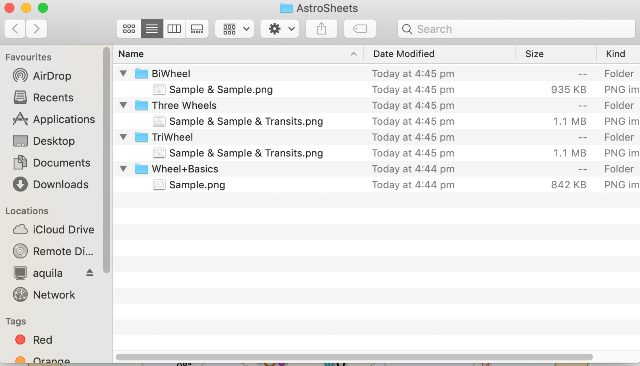 Astro Sheets folders and files |
The Sheets
For any of the selected charts you can view one of the astro sheets below. To determine the chart (or charts) to use, choose them from the dropdown lists at the top of the Astro Sheets window.
1 CHART - General
1) |
WHEEL: |
Single wheel |
2) |
GRID: |
Aspect grid |
3) |
WHEEL & GRID: |
Single wheel & aspect grid |
4) |
POINTS LIST: |
For each chart point - longitude, motion direction (D/Rx), travel, latitude, right ascension, declination, azimuth, altitude |
5) |
HOUSE CUSPS: |
Lists house cusp longitudes to second of arc plus a separate tabulation of nearest aspects from chart points to house cusps. Notably, this works with transformed house cusps of harmonic, duad and antiscia charts, rather than adopting the equal house cusps that are necessary for chart wheel display (as they keep the houses in a displayable order) |
5) |
SYZYGYS & ECLIPSES: |
Shows at birth the major lunar phases, and nearest prenatal and postnatal eclipses |
6) |
WHEEL + BASICS: |
A page of information => a single wheel, scores for elements/sign and house modalities/polarities => a list showing point glyph, longitude, motion direction (D/Rx), house; nearest aspects less than 1° orb sorted from smallest to largest orb
See NOTES below for information on how the score for elements, sign and house modes, and polarities are calculated |
7) |
BEGINNER / CLIENT: |
A page of information - general info on signs and aspects => a single wheel, scores for elements/sign and house modalities/polarities => a list showing chart point glyph, chart point, point sign, point house |
8) |
ASPECT PATTERNS |
Lists a range of standard aspect patterns found in the currently selected chart, showing which points are involved and a relative orb indicating the pattern tightness from 0.0 (tightest pattern orbs) to 1.0 (loosest pattern orbs). This is based on a root mean square ensemble calculation of all relative aspect orbs involved in the pattern. Clicking on an entry in the tabulation highlights that aspect pattern entry and applies a filter to the aspect ring of the selected chart's wheel, filtering it to show only the aspects involved in the selected pattern. The aspect patterms included are: •Stellium (any 3 points or more all conjunct one another) •T-Square •Grand Trine •Yod •Thor's Hammer •Grand Cross •Kite •Mystic Rectangle •Hard Rectangle •Focussed Yod •Rosetta •Hele •Double Yod Key •Square Key •Quintile Kite •Grand Quintile •Diamond •Stretched Pentagram •Star of David |
1 CHART - Predictive
7) |
PROG LUNAR |
Shows progressed lunar phases over the lifetime. |
8) |
LIFETIME ARCS: |
"Life Time Astrology" is a book by A.T.Mann describing a “time scale” that can be aligned with a chart to date significant events in the native's life. Astrology has a series of twelve houses that seem like a sequence, and lifetime arcs maps the houses to sequential influences in the native's lifetime. But rather than starting at the ASC as the birth moment, everything starts at the cusp of the 9th house as the Conception point, when the parents made love and conception occurred. Thus from the 9th house cusp to the Ascendent is the Gestation Octave, time within the mother which is an intrauterine repetition of the entire evolutionary process, which Jung called “The Collective Unconscious.” The native takes on karmic lineages from the father and mother, added to the mother’s attitude, feelings and experiences while she carries the native, as karmic imprints or samskaras (in Buddhism). The Ascendant is birth as a process of delivery, and echoes how the native expresses themselves. Childhood is represented by the first four houses up to seven years old, and is the development of the personality (emotional body) within the home and family system. From the 5th house cusp back up to the 9th house cusp is the Maturity Octave, stretching to the end of life out in the world. There is also a Transcendent Octave, a higher level of gestation which influences the higher, more collective impulses that are often transpersonal, beyond the daily personal life. The Life Time Arcs show a list of dates from Conception to Old Age in a logarithmic time scale, showing a sequence of planetary sensitive points (aspect angles from each planet’s natal position) that show a succession of planetary patterns that describe the life in time. This sequence is similar to the structure of DNA and are sequenced in groups of three (like midpoints ortriplicities) that show what happens as aging and growth occur.
=> For each arc there is a date, the aspect to the sensitive point, the radix chart point making the aspect, the native's age on that date, and the longitude of the sensitive point • Using the gear icon |
9) |
SUN SIGN WHEELS: |
For use when doing Sun Sign columns etc. For the selected chart this sheet shows 12 wheels, each with the Ascendent at 0° of a different zodiac sign |
1 CHART - Traditional
10) |
ESSENTIAL DIGNITIES: |
For each chart point - ruler, exaltation, triplicity, term, face, detriment, fall, the overall score for the planets out to Saturn Also shows the planetary day and hour, and the hour of the day or night the chart time is |
11) |
HOUSE |
Has a tabulation listing house cusp numbers, longitudes, dispositors and almutens (using traditional rulerships). |
12) |
PLANETARY SECT: |
Comprises sect (distinction between day and night) information for the chart. Diurnal The first column ("Pt") is the planet, and the second column ("nature") is the intrinsic sect nature of the planet (diurnal or nocturnal). The last column ("Munakara") delineates that the planet is in a state of contention. Planet A is in Munakara (state of contention) when it is ruled (using traditional rulers) by Planet B, which has a different sect nature to itself, and Planet B is ruled by Planet C which also has a different sect nature to itself. E.g. the Sun (has a diurnal sect nature) is in Aries, and so is ruled by Mars (which has a nocturnal sect nature). Because Mars rules the Sun yet has a different sect nature to the Sun, potentially there may be discord between them. Whether that potential discord will become actual then depends on the sect condition of the planet ruling Mars. If the sect nature of Mar's ruler is the same as the sect nature of Mars (nocturnal) no further disharmony is involved and the potential discord is unlikely to become actual. But if Mar's ruler has a different sect nature (i.e diurnal) to Mars sect nature (nocturnal), that means further disharmony is involved and the original disharmony between the Sun and Mars will manifest, and the Sun is in Munakara - a state of contention.
"Munakara gives us an idea of the dangers of crossing boundaries – twice – and the trouble a planet can get into when it moves through enemy territory. Imagine the youngest child in a family of three siblings. If the middle child is getting picked on by the eldest because they are suffering their own torments, then retaliation goes back to the smallest child, who risks danger from both its elder siblings. Each of the planets reacts differently to being in munakara according to its own character and its significations are often areas of stress for the individual". Munkara information is from Joy Usher, and her source is Al-Biruni, Book of Instruction in Art of Astrology, Notation 497, p. 308 |
13) |
DIGNITIES / HORARY: |
A page of information => planetary day and hour, a 30° modulus strip => a list showing point glyph, longitude, speed, travel, declination => a list showing point glyph, ruler, exaltation, triplicity, term, face, detriment, fall, score => a list showing a very few closest aspects with orb shown as time from exact |
14) |
DIGNITIES/ |
Shows the 16 closest Aspects, the Essential Dignities and the Planetary Sects. |
Time Lord activation in the Radix Chart
Planets become activated in a radix chart when they become "Time Lords". This means a planet becomes the highlighted planet in a chart via some technique's rules, and when it does then during a certain specified period of time it has an increased influence - in both the radix chart and also as transits to the chart.
These activations show when certain indications in the natal chart are most likely to manifest i.e. the planet ruling the activated sign will perform its best. The activations work by stepping through the chart, (traditional) planet by planet (and for Firdaria also the lunar Nodes), giving each planet (or node) “rulership” over a period of time in an individual’s life.
There are three such Time Lord based techniques available in Astro Gold - Firdaria, Profections and Zodiacal Releasings.
15) |
FIRDARIA: |
Firdaria show significant astrological periods from birth to age 100 Each planet has a period of greater years and a period of lesser years The individual’s life is broken up into time periods ruled by a planet or pair of planets The quality of life at that time is shown by the nature of the planets involved, along with their condition in the natal chart A Venus-Jupiter period would indicate great prosperity and joy, while a Mars-Saturn period would be one of hardship The only thing you have to determine is whether the chart is diurnal or nocturnal You then begin with either the Sun or Moon accordingly as the ruler of the first major period of life Each major period is divided into 7 sub-periods, ruled in order by the other planets, beginning with the ruler of the major period
=> The list shows each planetary period and within that its sub-periods, when that period or sub-period begins and the native's age at that time • In the gear icon |
16) |
PROFECTIONS: |
For the first year of life, by default the sign the Ascendant is in is the activated sign, and the ruler of that sign becomes the Time Lord for the first year After that, on your birthday each year, the following sign (in zodiacal order) becomes activated, and so the ruler of it then becomes the Time Lord for that year Thus after 12 years all the signs in the chart have become activated, so in the 13th year the first sign becomes re-activated again, and so on
=> First nine 12 year periods in the native's life are listed, labeled with the native's age at the beginning of the period (the first period starting at the chart date) For each 12 year period listed, the 12 years within it are shown, labeled with the native's age at the beginning of each year For each of those years the activated sign is shown, and it's ruling planet (which is the Time Lord for that year), plus the 12 months within it are also shown, labeled with the native's age at the beginning of each month, along with the activated sign and the Time Lord ruler of that sign
• The initial activated sign doesn't need to be sign the Ascendent is in. Using the gear icon Ascendent, Midheaven, Sun, Moon, Lot of Fortune |
17) |
ZODIACAL RELEASINGS: |
Also divide a person’s life into periods of time using activated signs, but the periods are longer e.g. decades The number of years a sign is activated, is the same as the years of its ruler's planetary period (orbital period) Any sign can be the sign that is (first) activated at birth, but by default the sign the Lot of Spirit is in is activated first. Use the gear icon Traditionally using the sign of the Lot of Spirit is best for things like worldly direction and career, and the Lot of Fortune for bodily health
Once the years associated with a sign have transpired in the native's life, the next period starts using the next sign in zodiacal order to the previous one, and so on There are also sub-periods that are months as opposed to years long (level2), and sub-periods within those lasting weeks (level3) and within that sub-periods lasting days (level4) In each level the same principle applies, i.e. the sign's ruler's planetary period is the number of years, or number of months, or number of weeks etc
=> Four levels are shown (years/months/weeks/days) with a list of activated signs applicable to each level, plus for levels 1 and 2 the native's age when each sign is activated, and for levels 3 and 4 the day and time when each sign is activated |
Additionally under 1 Chart Traditional are Lunar Mansions...
18) |
LUNAR MANSIONS: |
Are like a special zodiac just for the the Moon, based on the Moon's position relative to various groups of stars. There are 28 lunar mansions, corresponding to the average of 28 days it takes the Moon to circle the zodiac, are 12° 51' in the zodiac, starting at 0 Aries.
=> For all Displayed Points the Mansion number is listed, along with its English, Picatrix and Arabic nameClicking on a row in the list pops up a brief interpretation for the relevant Mansion. • The gear icon |
1 CHART - Midpoints
19) |
MIDPOINTS LIST: |
For each chart point and midpoint - modality, sign, longitude, modulus used, house. The modulus used can be 22.5°, 30°, 45°, 60°, 90°, 120°, 180°, 360° The list can be sorted by - point, sign, modality, modality & sign, or by modulus (if using this to sort by you also need to specify the specific modulus to use as well). |
20) |
MIDPOINT TREES: |
For each chart point - shows any midpoints (or other points) the chart point is directly aspecting by the modulus used, and the orb involved. The modulus used can be 22.5°, 30°, 45°, 60°, 90°, 120°, 180°, 360° The allowable orb can also be specified. The list is scrollable allowing trees of unlimited length |
1 CHART - Minor Bodies
21) |
ASTEROIDS LIST: |
Shows a list of Asteroids => glyph, name, number, longitude, motion direction (D/Rx), travel, latitude, right ascension, declination. • Using the gear icon |
22) |
ASTEROID ASPECTS: |
Shows the nearest aspects in a chart involving and asteroid or extra body, sorted from smallest to largest orb. • Using the gear icon |
NOTES re the Minor Bodies
[A] The makeup of the minor bodies is:
•Standard asteroids (50) - originally shipped
•Martha Lang Westcott's asteroids (71) - additional asteroids that can be downloaded
•Zane Stein's Centaurs & Dwarves (42) - additional extra bodies that can be downloaded
•Egyptian Mythological Asteroids (19)
•Muse Asteroids (11)
•All Asteroids & Extra Bodies (154)
>> How to Download additional minor bodies, plus also extend their calculation range
1)In the View menu click on Astro Sheets, or in the Toolbar click on the Sheets icon.
2)In the "Astro Sheets" window, in the left hand pane Tree menu, under the "1 Chart" heading, "Minor Bodies" sub heading, click on the Asteroids List sheet (see Tree menu if this sheet isn't visible).
3)In the top right of the "Asteroids List" sheet click on the Gear icon. The menu below will drop down...
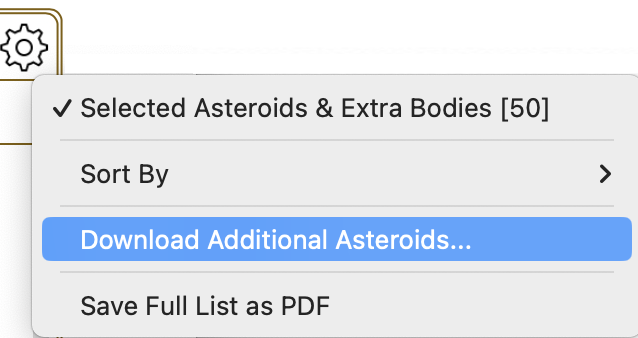
4)Click on Download Additional Asteroids. A dialog will pop up at the top of the Astro Sheets window, as below ...
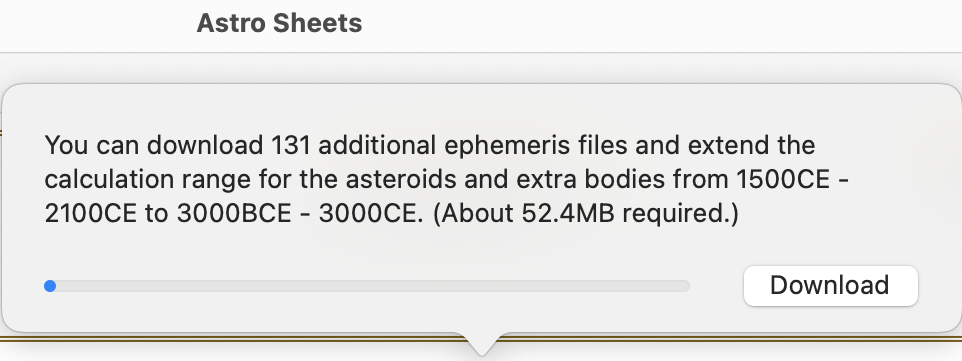
5)Click on the Download button to proceed, or click anywhere else in the Astro Sheet to cancel the download.
6)Once the downloading has finished, you need to turn the display of these additional minor bodies on. In the top right of the "Asteroids List" Sheet click on the Gear icon again. This time the menu that drops down is different...
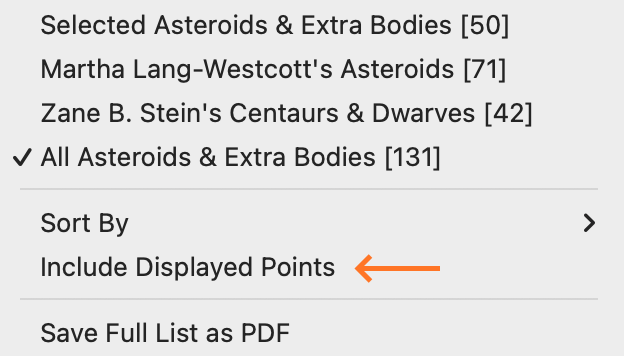
7)Select the set of minor bodies you want to be displayed in the Sheet.
NOTE: All of these additional minor planets will now also be available as Extra Points to put in charts along with all the other minor planets (see Displayed Points).
>> How to easily see asteroid conjunctions to the displayed points of the currently selected chart
1)In the View menu click on Astro Sheets, or in the Toolbar click on the Sheets icon.
2)In the "Astro Sheets" window, in the left hand pane Tree menu, under the "1 Chart" heading, "Minor Bodies" sub heading, click on the Asteroids List sheet (see Tree menu if this sheet isn't visible).
3)In the top right of the "Asteroids List" sheet click on the Gear icon. The menu below will drop down..

4)Click on Include Displayed Points. Now the displayed points of the chart the Astro Sheets are for will be included as points in amongst the asteroids in the Asteroid List.
5)When the list is sorted by longitude and declination the asteroids that are conjunct these displayed points will be immediately before or after them in the list.
1 CHART - Lots/Parts
23) |
ARABIC LOTS LIST: |
A list of Arabic Parts => name, longitude, house • Using the gear icon |
24) |
ARABIC LOT ASPECTS: |
=> Aspects from either Al Biruni's Parts, Bonatti's Commodities, Hellenistic Lots or the Seven Hermetic lots to other points in the chart, sorted from smallest to largest orb. • Using the gear icon |
NOTES re the LOTS
Hellenistic Lots: Source is Dorian Gieseler Greenbaum.
Dorian has practised and taught astrology since 1992. In 2009, she received her Ph.D. from the Warburg Institute, London.
Her book, based on her PhD, The Daimon in Hellenistic Astrology: Origins and Influence, was published in 2016. She is also known for her book Temperament: Astrology’s Forgotten Key (2005).
Dorian lectures and teaches internationally (FAA, UAC, the British AA, University of Wales Trinity St David on the MA in Cultural Astronomy and Astrology). Her interests include astrological lots and how the daimon works in astrology while her current passion is to rename the Part of Spirit to its correct name, the Lot of Daimon.
The Seven Hermetic Lots: Source is Chris Brennan
Chris has a special interest in the history, philosophy, and practice of ancient astrology, and specilises in the Greco-Roman tradition of astrology known as Hellenistic Astrology.
He is the former President of the Association for Young Astrologers, and the former Research Director of the National Council of Geocosmic Research. He was also an associate editor and columnist for The Mountain Astrologer magazine, and served on the board of Kepler College.
Chris now hosts of a weekly podcast called The Astrology Podcast, and runs The Denver Astrology Group.
Tables of Sensitive Points in Helenistic astrology, and according to Al-Burini: can be found at: Arabian Parts - Astrodienst Astrowiki
1 CHART - Fixed Stars
25) |
STARS LIST: |
=> name, magnitude, longitude, latitude, right ascension, declination • Using the gear icon |
26) |
STAR ASPECTS: |
=> point glyph, aspect, star name, orb ...sorted from smallest to largest orb • Using the gear icon The Star Sets available are: ❖All Named Stars [507] ❖Benhenian (Hermes) Stars [15] ❖Brightest Stars ( Mag < 2.0) [48] ❖Ecliptic Stars (Lat < 10.0°) [132] ❖Hermes Stars [15) |
27) |
STAR PARANS: |
Parans are mundane angles between stars and chart points that are (in any combination of) rising, culminating, setting or located at the IC (the paran types). => point glyph, point paran (rises/culminates/sets), star, star paran, orb • Using the gear icon |
>> How to easily see star conjunctions to the displayed points of the currently selected chart
1)In the View menu click on Astro Sheets, or in the Toolbar click on the Sheets icon.
2)In the "Astro Sheets" window, in the left hand pane Tree menu, under the "1 Chart" heading, "Fixed Stars" sub heading, click on the Stars List sheet (see Tree menu if this sheet isn't visible).
3)In the top right of the "Stars List" sheet click on the Gear icon. The menu below will drop down..
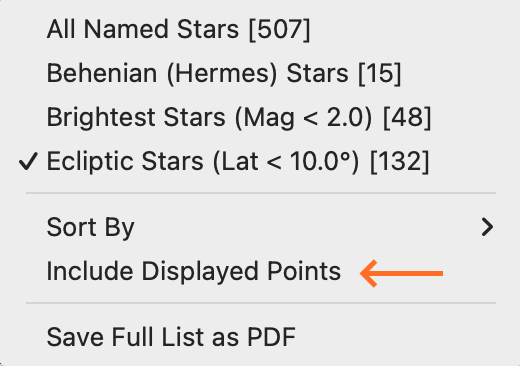
4)Click on Include Displayed Points. Now the displayed points of the chart the Astro Sheets are for will be included as points in amongst the stars in the Stars List.
5)When the list is sorted by longitude and declination the stars that are conjunct these displayed points will be immediately before or after them in the list.
1 CHART - Nodes & Apsides
28) |
NODES/APSIDES LIST: |
=> point glyph, point longitude, ascending (north) node longitude, descending (south) node longitude, geocentric distance, heliocentric distance, perihelion, aphelion All planets (except the Sun) have north and south nodes, just like the Moon does.
Apsides are the two key distances in the orbit of a planetary body about its primary body. In our solar system Perihelion is where a planet comes closest to the Sun, Aphelion is where a planet is furthest from the Sun.
Clicking on a row will pop up Heliocentric orbital parameters for that point: ❖status (approaching or receding from the Sun) ❖distance info ❖next exact apside date |
29) |
NODES/APSIDES ASPECTS: (nearest aspects) |
=> point 1 glyph, aspect glyph, point 2 glyph, point 2 name, aspect orb • Using the gear icon The Node/Apside Types available are: ❖Ascending (north) Node ❖Descending (south) Node ❖Perihelion ❖Apihelion |
2 CHARTS
30) |
BIWHEEL: |
A BiWheel showing one chart in the inner wheel and a second chart in the outer wheel |
31) |
BIGRID: |
A BiGrid (square shape), with planets from one chart across the top, and planets from a second chart down the left Where they intersect any aspect between the planet from chart and the planet from the other chart is shown |
32) |
SYNASTRY: |
A page of information for two charts => 2 biwheels with the charts in different rings, a synastry grid => a list showing chart 1 point glyph, aspect glyph, chart 2 point glyph, orb - sorted from smallest to largest orb |
33) |
DUAL WHEELS: |
A page of information for two charts => each chart in its own single wheel, a synastry grid |
3 CHARTS
34) |
TRI-WHEEL: |
A TriWheel showing one chart in the inner wheel, a second chart in the middle wheel and a third in the outer wheel |
35) |
THREE WHEELS: |
Three charts, each in their own single wheel |
4 CHARTS
36) |
QUADRI-WHEEL: |
A QuadriWheel showing one chart in the inner wheel, a second chart in the inner middle wheel and a third in the outer middle wheel, and a chart in the outer wheel |
37) |
FOUR WHEELS: |
Four charts, each in their own single wheel |
Some of the available lists in Astro Sheets contain types of information not available in other places in Astro Gold, such as:
1.Scores for sign and house modes, elements and polarities. These scores are a measurement of the overall strength of the modality, element or polarity in the chart.
When calculating the scores for each of these items Astro Gold takes into account both the number of planets/points having that modality, element or polarity, plus the significance of each planet/point in the chart. Significance is related to how important in terms of everyday functioning that planet/point is on average, and the level of conscious access to that planet or point's energy/reality that is generally experienced.
Astro Gold initially assigns a score of 1 for each planet/point that belongs to a particular modality, element or polarity.
That initial basic score is then weighted according to it's significance, by multiplying it by the values below:
a.Multiplier 3 - Sun, Moon, Ascendant, MC
b.Multiplier 2 - Mercury, Venus, Mars
c.Multiplier 1 - Jupiter, Saturn, Uranus, Neptune, Pluto
d.Multiplier 0 - All other chart points
2.A more detailed list of chart points' data, midpoint trees, firdaria, profections and zodiacal releasings, and star parans/aspects etc
a.Firdaria uses the "Standard" system - with nodes at the end of the sequence by default. However you can change the system used to "Nodal Variant" in Preferences, Calcs.
b.Star Aspects and Star Parans are fixed star listings that utilize one of 5 pre-supplied Star sets.
c.Asteroid listing and aspects.

